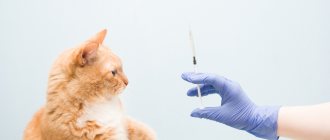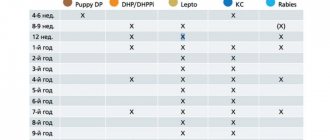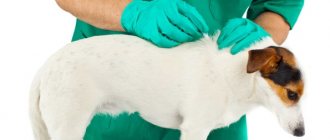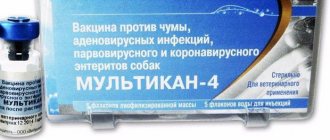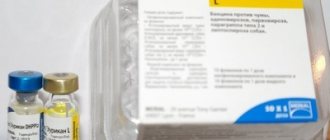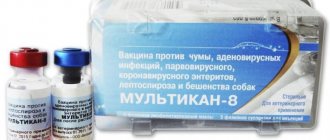Vaccination is one of the most important measures to prevent infectious diseases in domestic dogs, as well as animals living on the street. Vaccination helps prevent the spread of dangerous diseases not only in the dog population, but also among people living in the same area. In particular, routine immunization is a sure way to protect yourself from rabies; the disease is one of the incurable diseases and leads to the inevitable death of infected organisms.
It is important to remember that a dog’s reaction to vaccination can be very different. In most clinical cases, vaccination is well tolerated by the pet, but sometimes it provokes the development of undesirable effects: from the formation of a subcutaneous lump to complex forms of allergies. Therefore, every breeder of a four-legged friend must know what condition after vaccination is normal, and when to immediately seek veterinary help.
What is rabies in dogs?
Rabies is a naturally occurring infectious disease of the zooanthroponotic type, deadly for most animals and people. The disease develops when viruses from the Rhabdoviridae family, namely Rabies virus, enter a living body. The viral disease is very acute (less often subacute, chronic), manifested by gross disturbances in the functioning of the nervous system, hydrophobia, violent behavior and excessive salivation.
In nature, reservoirs for rabies pathogens are wild dogs, in particular bats, wolves, foxes, rodents and birds. Infection of dogs and humans occurs through the ingress of saliva from an infected animal into a bite wound. The incubation period lasts from several days to a month, after which the main symptoms of the pathological process appear. The disease is always fatal, since there is currently no medicine that can inactivate the rabies virus.
Dog breeders must remember that today the only way to protect themselves from this terrible disease is the passive development of immunity through routine vaccination of dogs, that is, vaccination against rabies.
Cases of immediate contact with veterinarians
There are, albeit infrequently, situations when immediate assistance from a veterinarian is required.
| Firstly | Deterioration in health, vomiting and diarrhea for a couple of days, refusal to eat for the same period, high temperature and the appearance of convulsions clearly indicate serious problems and the need to consult a specialist. |
| Secondly | Manifestation of abscess processes in the injection area. The lump increases in size, turns red, and in some cases purulent formations are released from it. Do not try to open the tumor yourself; just like in humans, this is fraught with infection, including blood, with all the ensuing consequences; take your pet to the doctor. In this case, a house call is impractical, since surgical intervention requires sterile clinic conditions. |
| Third | Anaphylactic shock. This is perhaps the most serious and life-threatening condition, when the help of a doctor is required immediately, and we are talking about hours. Allergies are rare, but they do happen, and you need to be prepared for such a turn of events. As a matter of fact, due to possible allergic reactions, it is best to do vaccinations in a clinic under the supervision of a doctor, and not by making a house call, when the injection was given and left. |
Preparing for vaccination
Vaccination against rabies is the only real way to prevent the disease. Today, immunization of dogs is carried out by introducing vaccine solutions of Russian or foreign production, which contain inactive (weakened) cultural strains of the causative agent of the disease.
Veterinarians recommend that the following categories of dogs be vaccinated:
- if the animal takes part in breeding;
- pets that often travel with the owner;
- inhabitants of regions where outbreaks of rabies are periodically recorded;
- representatives of hunting breeds;
- dogs participating in exhibitions, international shows, etc.
Lasting immunity is formed 3-5 weeks after vaccination, when a sufficient number of active antibodies are formed in the pet’s body to protect against infection. The duration of such passive protection after vaccination against rabies is about 24-36 months, so after a year the animal should be revaccinated.
The first rabies vaccination should be given when the puppy reaches 3 months of age or after replacing baby teeth with permanent teeth. If a young dog is vaccinated with a polyvaccine, it needs to be revaccinated 3-4 weeks after the first administration of the vaccine. Adult members of the family must be vaccinated annually. The optimal vaccination plan is drawn up by a veterinarian.
To ensure that there is no deterioration after vaccination, it must be carried out in accordance with certain rules:
- You cannot vaccinate dogs that show symptoms of any infectious process;
- before vaccination it is necessary to carry out deworming;
- It is better to vaccinate a dog in a specialized institution;
- Immediately before administering the solution, the veterinarian must examine the pet and make sure there are no contraindications to the procedure.
After vaccination, the dog must be quarantined for two weeks, excluding any contact between the pet and street animals. It is important to ensure that your pet does not overheat or become hypothermic and is not subjected to intense physical activity. It is strictly forbidden to bathe your dog for a week after vaccination.
How to avoid complications after vaccination?
The occurrence of severe conditions after vaccination can occur in cases where the dog was sick or did not fully recover from the disease. In weakened animals, administration of the vaccine can cause a significant deterioration in general health. You should not ignore the possibility of danger of infection after vaccination (meaning the period of several weeks after vaccination). After vaccination, the dog should not walk with other dogs or come into contact with objects that other animals have used. Many sick dogs are brought to the veterinary clinic, so you should avoid contact with them and not linger unnecessarily in such establishments.
A dog may be lethargic and inactive after receiving a rabies vaccination. She needs to be monitored for 3-5 days. If there is no improvement, then you need to contact a veterinarian as soon as possible. As a rule, the first 15-25 minutes after vaccination and the second or third day are dangerous. It is recommended to pay special attention to the dog’s condition after repeated vaccination, as the risk of allergic manifestations increases.
Vaccination immediately after deworming a dog is contraindicated, as the immune system is weakened. After 1-2 weeks after deworming, the body will be ready for vaccination.
After vaccination, you must undergo quarantine. After the first vaccination it is 10-14 days. Walking your dog after vaccination should be done with extreme caution. The puppy is walked without contact with the surface. Being held in his arms, he simply breathes fresh air. Contact with other animals is completely excluded.
As a rule, these restrictions are not imposed on adult dogs. This period is characterized by monitoring the pet’s condition in case of unforeseen situations. Walks take place on a leash, without contact with other animals. You cannot bathe your dog after vaccination, as its immunity is weakened. Ignoring this factor can lead to hypothermia of the pet and various complications.
Possible complications of vaccination
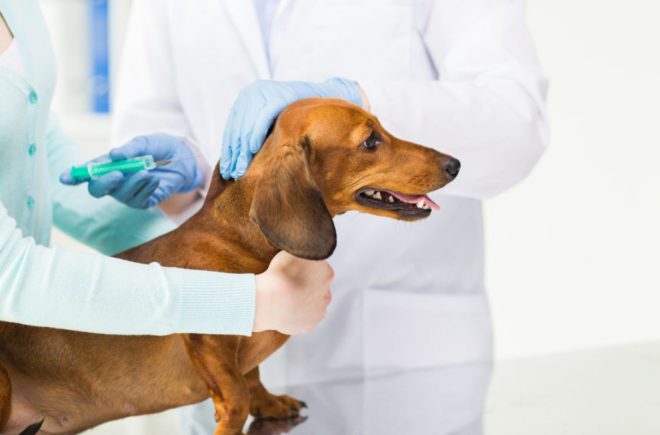
As a rule, modern rabies vaccination very rarely causes the development of adverse reactions in dogs, since it is considered a perfect immunobiological preparation that has passed all the necessary tests. But still, there are cases when the introduction of a vaccine is accompanied by the development of pathological reactions from the animal’s body.
Most often, after vaccination, representatives of the canine family experience disorders; they are among the normal consequences of immunization and should not cause panic in the pet owner:
- one-time refusal of food by the dog;
- one-time disturbance of stool or vomiting;
- insignificant and short-term increase in general body temperature (39.2 - 39.50 C);
- lethargy during the day when the vaccination was given;
- the appearance of a painless lump or lump at the injection site should disappear without a trace after 10-14 days.
Immunization complications that require your dog to be seen immediately by a veterinarian include:
- the occurrence of signs of allergy to the vaccine and signs of anaphylaxis;
- severe pain at the site of vaccine injection;
- intense, repeated vomiting;
- severe weakness and refusal to eat during the day;
- a persistent increase in the pet's temperature by 10 C compared to the norm;
- salivation with the appearance of serous discharge from the eyes and nasal passages;
- development of shortness of breath and symptoms of hypoxia (cyanosis of the mucous membranes, hyperemia of the ears);
- the appearance of convulsions, muscle twitching;
- when the dog begins to limp or pulls its hind legs.
Such disorders after vaccination occur mainly due to a poor-quality vaccine or if the time of vaccination coincided with the latent period of another developing disease. Side effects may also occur in dogs that were given the injection without following all the necessary rules.
Content
Vaccinations for puppies are mandatory. Whatever the “yard specialists” say, these injections make it possible to form the correct immunity and develop resistance to serious diseases, such as animal distemper. However, the dog may become ill after vaccination.
It is important to understand that in this situation there is no need to panic, but it is also unacceptable to let the process take its course. Initially, it is worth knowing that with vaccination, virus cells are introduced into the puppy’s body, albeit in a non-functional format. Naturally, the immune system begins an active fight against them. As a result, it weakens and is less resistant to other infections. Therefore, your pet may experience some complications after the injection.
Other possible consequences of dog injections
Many pet owners believe that a lump after an injection in a pet is a trifle not worth attention. But sometimes the consequences of injections can even lead to the need for surgical interventions, and in rare cases, even death. So, incorrectly given injections are fraught with:
- Abscesses. In dogs, this occurs when pyogenic bacteria invade the tissues. It is strictly forbidden to open an abscess yourself or puncture it. It looks like a lump, swelling, hot and painful to the touch. Therapy consists of applying compresses with ointments that draw out the pus, but more often they resort to surgical cleaning of the affected area with an incision, evacuation of pus, and treatment with an antiseptic. You cannot treat an abscess on your own. And if you let it go and delay a visit to the veterinarian, then necrosis and sepsis are possible.
- Infiltrate. It forms when an injection is given with a dull needle or when it breaks during an injection. Perhaps the dog jerked sharply during the injection or the medicine was injected into a tense muscle. The colder the drug, the worse it is absorbed. This leads to infiltration. It is unlikely that the owner himself will be able to distinguish between it and an abscess, so it is better to turn to a good veterinarian for help. Treatment is usually prescribed in the form of anti-inflammatory ointments and compresses.
- Hematoma. Its reason is an unsuccessful choice of injection site. In this case, the blood flows out and a dense ball called a hematoma appears. It can also be caused by several injections in one place. Hematomas are treated with light massage and warm compresses.
- Collapse (sharp decrease in pressure). This is one of the most dangerous consequences of an incorrect injection. Like pulmonary embolism, this condition requires veterinary intervention.
Why did the dog start to tremble after vaccination, what should I do?
Almost all dog vaccinations have side effects. You can talk about their appearance if, after vaccination, a puppy or an adult pet shakes, refuses to eat, and becomes weak and lethargic. This is just the dog’s body’s reaction to the vaccine. The intensity of negative consequences after vaccination depends on the age of the dog and the characteristics of its body.
The trembling and lethargy usually go away on their own. If after vaccination the pet’s condition worsens, you should not ignore this phenomenon, as this can lead to the death of your four-legged friend. To prevent the dog from becoming ill after vaccination, the procedure must be carried out in a trusted veterinary clinic, properly prepare the dog for vaccination and strictly follow the recommendations for caring for the vaccinated animal.

